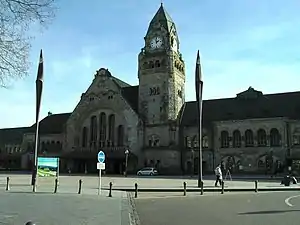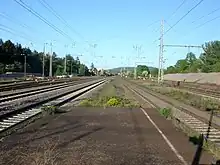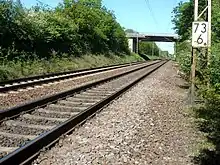Kanonenbahn
The Kanonenbahn (literally "Cannons Railway") is a former German military strategic railway between Berlin and Metz via Güsten, Wetzlar, Koblenz and Trier. Metz is in Alsace-Lorraine, which was annexed by Germany after the Franco-Prussian War.

Other railways, such as the Glan Valley Railway (Glantalbahn), built mainly for military strategic reasons, were also colloquially known as the Kanonenbahn, but the link between Berlin and Metz is the best known of them.
Derivation of name
 Logo of the Berlin-Coblenzer Eisenbahn on a waiting room bench |
 Bench of the Berlin-Coblenzer Eisenbahn |
 Moselle line (Wittlich) |
Kanonenbahn is not an official name for the line. There are a number of other names for the line or sections of it:
- Berlin–Metz Railway (Berlin-Metzer Bahn)
- Wetzlar Railway (Wetzlarer Bahn) or Berlin–Wetzlar Railway (Berlin-Wetzlarer Bahn)
- Berlin–Coblenz Railway (Berlin-Coblenzer Eisenbahn, BCE)
- Berlin–Blankenheim Railway (Berlin-Blankenheimer Bahn)
- Moselle line (Moselstrecke)
Four different railway divisions were responsible for the supervision of the construction of sections of the line and used different names for the line. For example, the official tender for construction of the line in Eichsfeld described the line as the Berlin–Coblenz Railway. The initials "BCE" are found on benches and chairs in railway stations and various buildings on the line.
Background
Strategic railways are lines built on military grounds without regard to the economics or the potential civilian traffic on the line in peace times. Certain design parameters such as minimum curve radius, maximum gradient and maximum load had to be met. It was planned as a double-track line with the aim to bypassing urban areas where possible.
The military expressed interest in a continuous railway at an early date. For example, as early as 1855 the private sector lobbied the Prussian Minister of Commerce, Trade and Public Works for a railway through the Moselle valley from Koblenz to Trier. It was claimed that such a line would carry gypsum, slate and iron ore. The president of Rhine Province wrote in response two weeks later on 31 August 1855 that the War Ministry has repeatedly stressed the military importance of a railway from Koblenz to Trier and supported the immediate building of such a line, which would form a natural extension a railway line from Berlin via Halle, Kassel, Gießen, Wetzlar to Koblenz, running to the south western periphery of the kingdom of Prussia. It would at the same time provide a direct connection between the central Rhine, the most remote part of Prussia, the old Prussian provinces and the centre of the state (Berlin). However, it would be more than 15 years before the project was completed.
No later than 1871, preliminary studies were carried out of the route of the line, selecting a route that for the most part had little or no civilian importance for traffic and which bypassed urban areas. Private plans for the railway’s construction were rejected with state funding available from the French reparations. On 12 June 1872, the Verein für die Gründung einer directen Eisenbahn von Berlin nach Frankfurt am Main ("Association for the establishment of a direct railway from Berlin to Frankfurt am Main") applied to the Prussian Minister of Trade, Commerce and Public Works for a concession for a railway line. This request was rejected only 14 days later on the grounds that the government was planning a direct connection between the eastern and western railways networks and that the government intended to take into account the need for a line from Berlin to Frankfurt am Main. In 1872 surveyors and engineers had already staked out the planned line on the Lollar–Wetzlar section.
On 18 December 1872 the Prussian government presented a plan for the construction of the Berlin–Wetzlar railway to the Prussian House of Representatives. An act “for the issuing of a bond in the amount of 120 million Thalers to extend, complement and improve the equipment of the state railway network of 11 June 1873”, known as the Kanonenbahngesetz (“Cannons Railway Act”) authorised the construction of the railway using French reparations and authorising bonds to be raised for the line.
Sections
The entire route has a length of about 805 km, of which around 511 km was built under the Cannons Railway Act. These were mainly the Berlin–Blankenheim line (Wetzlar Railway or Wetzlar line), the Leinefelde–Treysa line and the Koblenz–Trier–Thionville line. There were also two new short sections, the Lollar–Wetzlar line and a new connection from Hohenrhein to Koblenz over the Rhine. The remaining sections of the railway used existing lines, which included the Halle–Kassel line, the Thuringian railway’s Gotha–Leinefelde branch line, the Main-Weser Railway, the Lahntal railway and the French Chemins de fer de l'Est’s line to Metz.
The project included the upgrading of these existing routes for the Cannons Railway such as the duplication of the Lahntal railway. The Cannons Railway was opened in 24 sections. These were:
| Section | Length km |
Opening | Line | |
|---|---|---|---|---|
| 1. | Charlottenburg–Grunewald | 3.12 | 1 June 1882 | Berlin-Blankenheim line |
| 2. | Grunewald–Sandersleben | 160.29 | 15 April 1879 | Berlin-Blankenheim line |
| 3. | Sandersleben–Hettstedt | 6.43 | 10 January 1877 | Berlin-Blankenheim line |
| 4. | Hettstedt–Blankenheim | 18.56 | 15 April 1879 | Berlin-Blankenheim line |
| 5. | Blankenheim–Nordhausen | 50.50 | 10 July 1866 | Halle–Kassel line |
| 6. | Nordhausen–Leinefelde | 42.26 | 9 July 1867 | Halle–Kassel line |
| 7. | Leinefelde–Silberhausen-Trennung station | 8.22 | 3 October 1870 | Gotha-Leinefelde line |
| 8. | Silberhausen-Trennung–Eschwege | 37.69 | 15 May 1880 | Leinefelde–Treysa line |
| 9. | Eschwege–Niederhone | 3.29 | 31 October 1875 | Leinefelde–Treysa line |
| 10. | Niederhone–Malsfeld | 40.41 | 15 May 1879 | Leinefelde–Treysa line |
| 11. | Malsfeld–Treysa (old station) | 40.39 | 1 August 1879 | Leinefelde–Treysa line |
| 12. | Treysa (old station)–Kirchhain | 26.93 | 4 March 1850 | Main-Weser Railway |
| 13. | Kirchhain–Marburg | 15.09 | 3 April 1850 | Main-Weser Railway |
| 14. | Marburg–Lollar | 21.63 | 25 July 1850 | Main-Weser Railway |
| 15. | Lollar–Wetzlar | 18.04 | 15 October 1878 | Lollar–Wetzlar line |
| 16. | Wetzlar–Weilburg | 23.03 | 10 January 1863 | Lahntal railway |
| 17. | Weilburg–Limburg | 2914 | 14 October 1862 | Lahntal railway |
| 18. | Limburg–Nassau | 26.39 | 5 July 1862 | Lahntal railway |
| 19. | Nassau–Bad Ems | 7.91 | 9 July 1860 | Lahntal railway |
| 20. | Bad Ems–Hohenrhein | 10.34 | 1 July 1858 | Lahntal railway |
| 21. | Hohenrhein–Koblenz | 7.09 | 15 May 1879 | Lahntal railway |
| 22. | Koblenz–Ehrang | 105.25 | 15 May 1879 | Moselle line |
| 23. | Ehrang–Diedenhofen (new) | 76 | 15 May 1878 | Thionville–Trier line |
| 24. | Diedenhofen (old)–Metz (old) | 27 | 16 September 1854 | Metz–Luxembourg railway |
| Total length | 805.00 | from 4 March 1850 | ||
For the management of the construction of the Cannons Railway, four Royal Railway Divisions (Königliche Eisenbahndirektionen, KED) and General Division of the Imperial Railways in Alsace-Lorraine were in charge:
- Berlin–Nordhausen: KED Berlin
- Nordhausen–Eschwege–Treysa–Lollar: KED Cassel, from 1 April 1876: KED Frankfurt (M)
- Lollar–Wetzlar, Oberlahnstein–Coblenz–Güls, Hohenrhein–Niederlahnstein: KED Wiesbaden
- Güls–Ehrang–border near Sierck: KED Saarbrücken
Further development
In 1880–1882, the railway was completed throughout. During the planning and construction, however, the Prussian main railway network was nationalised. A major reason for the construction of the railway, the independence of the various private railway companies, was thus already eliminated at, or shortly after, its completion. Similarly, the building of the line far from urban areas for strategic reasons proved to be an obstacle to the development of traffic. For through traffic, the whole line was never important. In places, the line did not need the originally planned double track. In the following years, individual sections of the route developed very differently. Some sections, such as Berlin–Wiesenburg or Koblenz–Trier attracted through traffic. Others had only local importance.

In 1945 the line was divided by the Inner German border between Geismar and Schwebda. This meant that the Cannons Railway was no longer a continuous line and it decreased the importance of the Hessian sections. In 1974 passenger services on the Malsfeld –Waldkappel section were abandoned, which was followed by the closure and dismantling of that section and in other sections in Hesse. After 1990, sections that had been in East Germany were also closed.
References
- Eduard, Fritze (2003). Die Eichsfelder Kanonenbahn 1880–1994 und der Bahnhof Küllstedt (in German). Bad Langensalza: Verlag Rockstuhl. ISBN 3-936030-05-7.
- Günter, Fromm (2000). Die Geschichte der Kanonenbahn. Leinefelde – Eschwege 1880–1945 – Leinefelde – Geismar 1880–1992 (in German). Bad Langensalza: Verlag Rockstuhl. ISBN 3-932554-98-1.
- Rolf, Gießler (1983). Kanonenbahn … und zwischen den Gleisen wächst das Gras (in German). Spangenberg.
- Kurt, Hoppstädter (1973). Die Eisenbahnen im Moseltal nach den Akten des Staatsarchivs Koblenz (in German). Saarbrücken: Eigendruck der Bundesbahndirektion.
- Wolfgang, Klee (1998). Die Kanonenbahn Berlin – Metz. Stuttgart (in German). Transpress. ISBN 3-613-71082-X.
- Jürgen, Krebs (2004). Kanonenbahn Berlin – Sangerhausen. Zwischen Fläming und Mansfelder Land (in German). Herdam Fotoverlag. ISBN 3-933178-09-6.
- Paul, Lauerwald (1998). Die Kanonenbahn Leinefelde–Eschwege West (in German). Quedlinburg. ISBN 3-933178-01-0.
{{cite book}}: CS1 maint: location missing publisher (link) - Emil, Winter (1995). Die Bahnstrecke Lollar–Wetzlar oder Die Kanonenbahn 1878 bis 1990 (in German). Heuchelheim. ISBN 3-926923-17-2.
{{cite book}}: CS1 maint: location missing publisher (link)
External links
- "Kanonenbahn" (in German). www.kanonenbahn.de. Retrieved 16 December 2010.
- "Description of Leinefelde–Treysa line" (in German). Retrieved 16 December 2010.
- "Erlebnis Kanonenbahn" (in German). Retrieved 16 December 2010.
- "Erlebnis Draisine" (in German). erlebnis-draisine.de. Retrieved 16 December 2010.
- "Photographs of tunnel portals on the Leinefelde–Treysa line" (in German). Tunnelportalen. Retrieved 16 December 2010.
